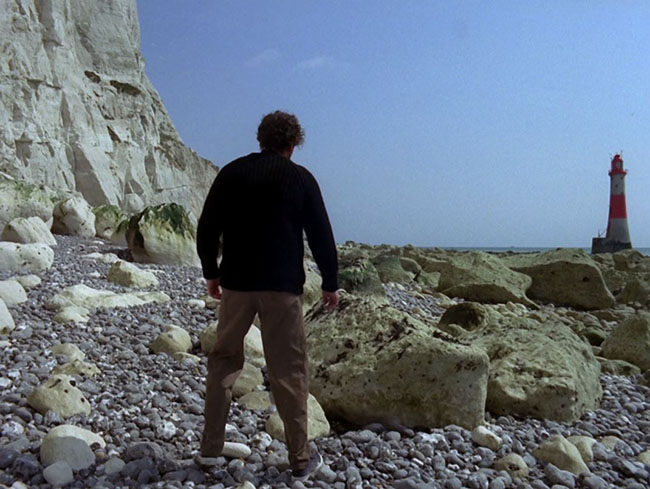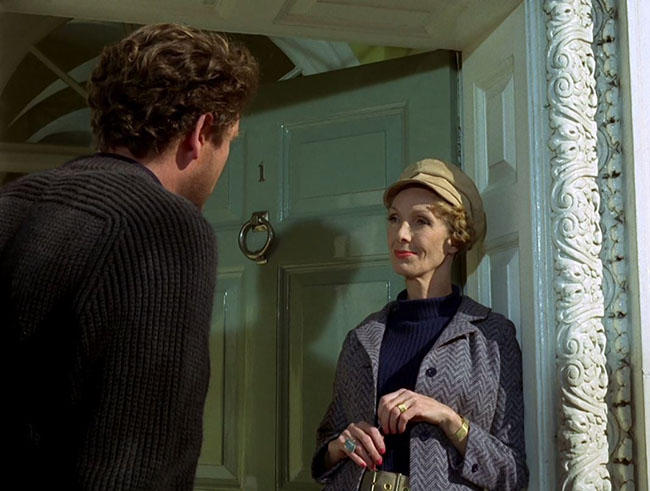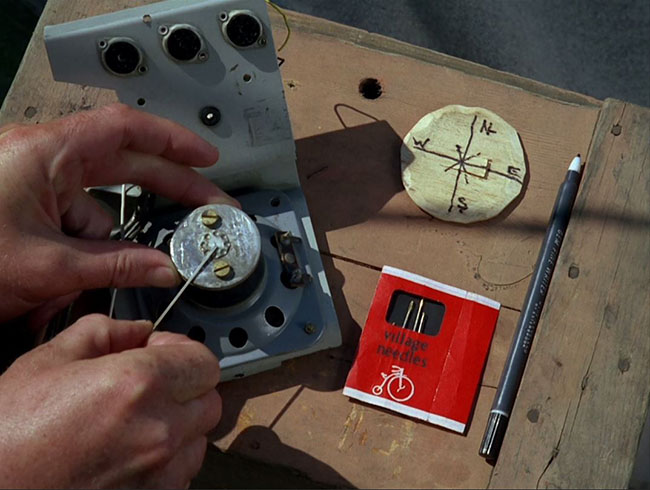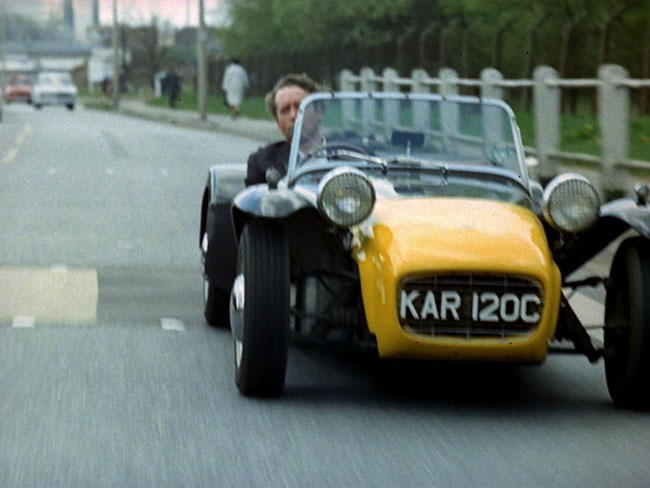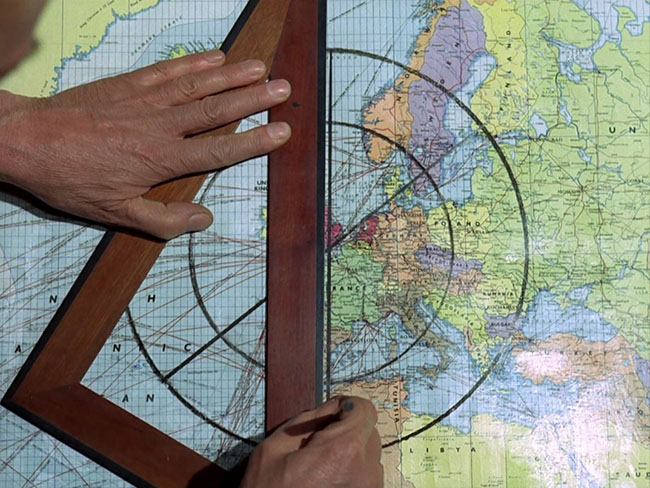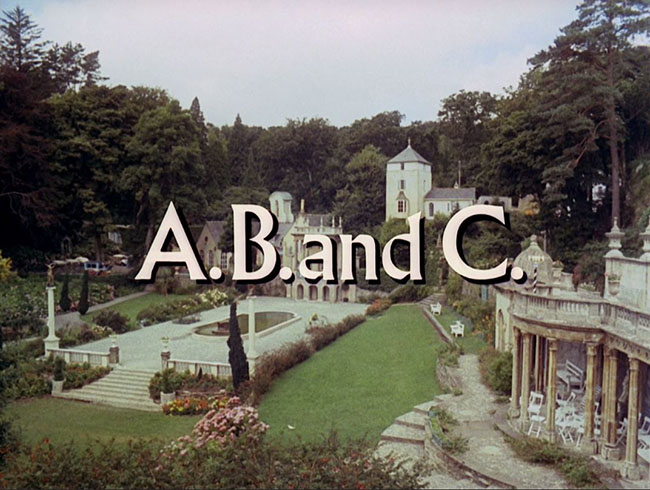
A. B. AND C. First UK Broadcast: October 13, 1967 [episode #3 in transmission order] | Written by Anthony Skene | Directed by Pat Jackson
SYNOPSIS
No.2 (Colin Gordon, returning from “The General“) is facing pressure to get to the bottom of the reason for No.6’s resignation. He decides to take drastic measures by proceeding with an experimental method devised by No.14 (Sheila Allen), even though it’s untested. The procedure will manipulate No.6’s dreams, allowing them to create a scenario and introduce characters from No.6’s life outside the Village. No.2 believes No.6 was prepared to sell out, and he wants to know to whom he was going to sell his secrets. There are three potential candidates, whose files are designated A. B. and C. In his manufactured dream, No.6 is at a party thrown by his friend Madame Engadine (Katherine Kath). He first meets A. (Peter Bowles), but A. gets nowhere with No.6, resorting to violence. After his first session, No.6 begins to suspect No.2’s plot, recognizing No.12 while she’s buying flowers – a woman from his dreams. He also discovers an irritated needle mark on his wrist. But the experiment proceeds; he is drugged and taken back to the laboratory to meet his next contact in his dreams, B. (Annette Carrell). She’s a spy who claims that she’ll be killed unless No.6 gives her information, but he exposes her as a fraud when she can’t answer personal facts about her life; this is because her dialogue is being fed to her by No.14. Before his last session, No.6 follows No.14 to her secret lab, finds the files marked “A. B. and C.,” as well as a syringe. He replaces the drug with water. When he’s brought back into his dreams for the final experiment, he’s now able to manipulate them himself. He meets C. – who turns out to be Engadine – and they agree to meet with a mysterious fourth stranger (“D.”) for a transaction. But No.6 casts No.2 as D., handing him travel brochures and itineraries. “I wasn’t selling out,” No.6 says. “That wasn’t the reason I resigned.” The red phone of No.1 rings, and No.2 realizes that he has failed.
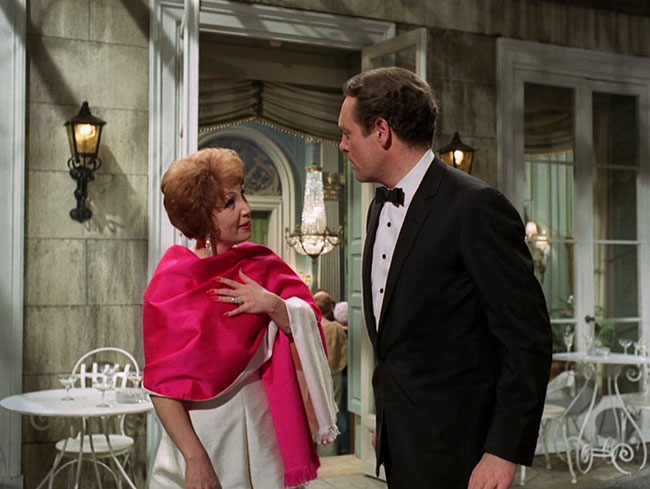
No.6 meets with Madame Engadine (Katherine Kath) in his dreams.
OBSERVATIONS
This is one of the most memorable episodes of The Prisoner, appropriately mind-altering just in time for the brief heyday of psychedelia. Roughly half the episode takes place in drug-fueled dreams, and when No.6 takes control of his final session, the camera tilts and sways and things get trippy fast, culminating in an extraordinary sequence where the dream No.6, viewable on a large screen in the lab, walks into the Village, through the woods, into the hidden door and right into the lab with No.2 and No.14. Paranoid, No.2 turns to look at the real door, as though No.6 might actually be entering the room. It’s reality caving into dream logic. The monitor returns to the opening credits, a loop of No.6 resigning over and over again. This was a very meta series for its time. The screenplay is by Anthony Skene, one of the writers who seemed to “get” the show, having also contributed the standout episodes “Dance of the Dead” and “Many Happy Returns.” Admittedly, his script was originally prepared for the BBC show Counterstrike before it was reworked for The Prisoner, but it’s a perfect fit. He pulls off the trick of creating drama within a very static setting: a laboratory, with an unconscious No.6 and imaginary scenarios that the audience knows aren’t real. To have No.6 make progress in foiling the plot during his waking hours provides the necessary tension, with a climax which mimics the hypnopompic state of being almost-awake and taking agency in one’s dreams. There is also a winking reference to the mad scientist nature of the story, replete with stock footage of flashing lightning while No.6 is wheeled into the lab on a rainy night.
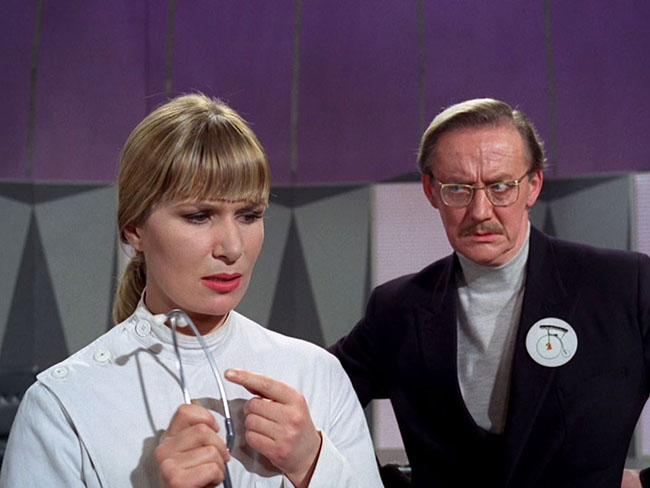
No.14 (Sheila Allen) and No.2 (Colin Gordon) conduct an experiment in controlling No.6’s dreams.
It’s a rare occurrence that No.1’s unseen presence hovers over a story, and here he’s represented by the oversized red phone, curved and making a thrumming kind of ring which No.2 dreads. He drinks milk to calm his nerves and possibly treat his ulcers. No.2 is convinced that No.6 resigned to sell information, which is an unobservant conclusion given how rigidly principled 6 is. Since “The General” implied that he’s been watching No.6 for quite some time, it says something about No.2 that he’s this clueless about his subject. Nonetheless, the episode concludes with some definitive information for the viewer: no, No.6 was not selling out, in case anyone actually thought that. Having failed, No.2’s fate is uncertain. Freeze-frame the Tally Ho headline that No.14 is reading in a Village café and you’ll see it says “Is No.2 Fit For Further Term?” At the start of the episode, No.2 is telling No.1 over the phone, “I know sir, yes. I know I’m not indispensable.” Given the ominous shot of No.2 staring at the ringing phone at the end, we can conclude that this No.2’s time in office is over.
The premise provides the opportunity for a larger than usual cast. As the worldly social butterfly Engadine, French actress Katherine Kath (Moulin Rouge, Gigot) shines; it is easy to believe that she would be among the Prisoner’s circle of contacts. (In fact, when I first saw this episode decades ago I was confused, thinking she was a recurring character that I had somehow missed before.) As the reticent No.14, Sheila Allen also makes a strong impression; she’s a sympathic figure that’s been roped into this scheme by a desperate No.2. Georgina Cookson, who played No.2 in “Many Happy Returns,” has a bit part as one of Engadine’s guests, a surprisingly conspicuous bit of re-casting.
SEQUENCE
I’ve already explained why this should go after “The General,” as the climax spells the end of this No.2, but it should also be pointed out that in the opening credits he says “I am No.2” instead of “the new No.2,” an edit which indicates this was intended to follow the prior Colin Gordon episode. In both of these No.6 comes out on top and demonstrates that he’s learning how to get the upper hand on his captors. This trend will guide him through the rest of the season, leading to an ultimate confrontation in “Once Upon a Time.”
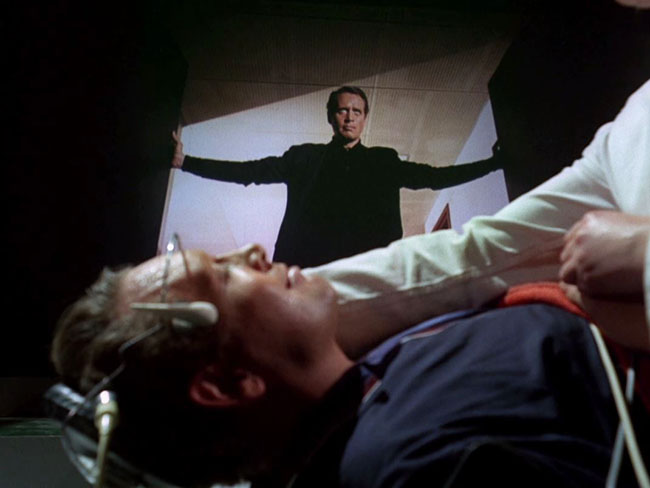
No.6 learns to control his dreams, which are projected upon the wall.
THE OUTSIDE WORLD
Even if it’s just in dreams, we get another look at No.6’s life before the Village in this episode. We learn of his former associates Madame Engadine, “A,” and “B,” all of whom are involved in the espionage game. It could easily be the world of Danger Man/Secret Agent, but we see it through the kaleidoscope view of No.6’s manipulated unconscious. He even has a quasi-romantic dance with “B,” rare given McGoohan’s objections to that sort of thing.
FISTICUFFS
Surprisingly for an episode that takes place in dreams, there are two fight scenes, as No.6 gets in a scuffle with the henchmen of “A” and the agents who come after “B.”
WIN OR LOSE?
This is a win for No.6, and a definitive defeat for No.2.
QUOTES
“A”: What are you going to do with your freedom?
No.6: Go fishing.
“A”: Perhaps you’re fishing now.Engadine: It takes you a long time to sell yourself, darling.
No.6: It takes a lot of thought.No.6: This is a dreamy! Party!
UP NEXT: Before we take on the next episode, a look at the Prisoner scripts that never made it to production.
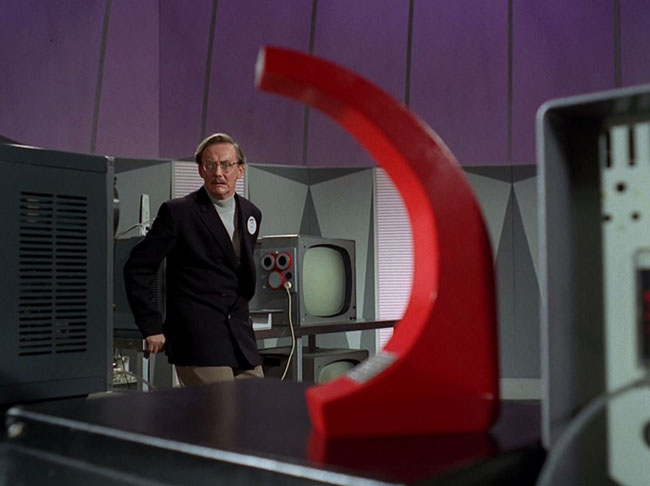


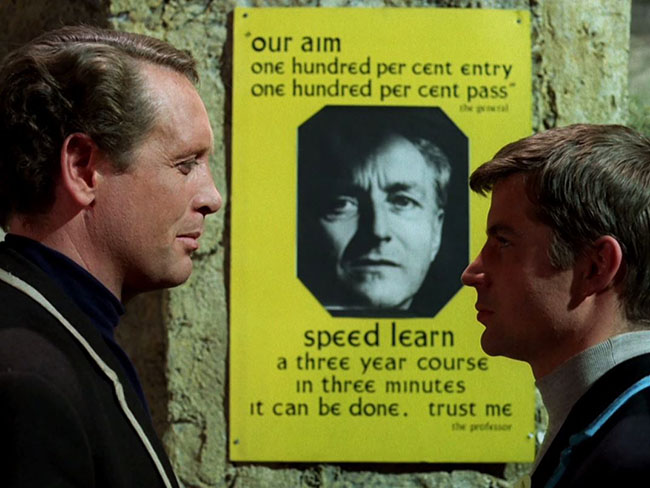
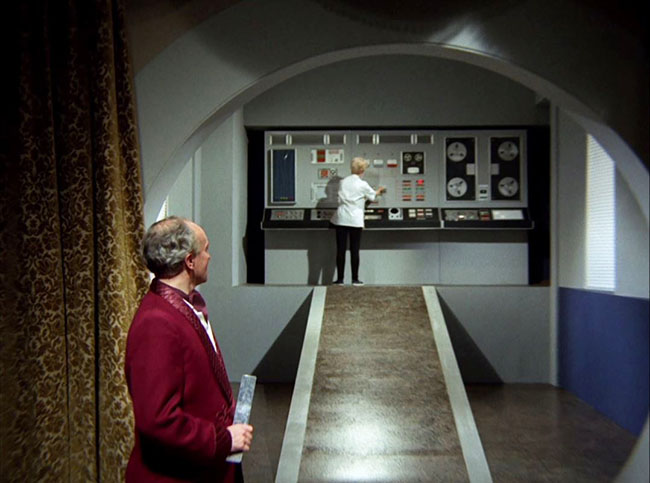
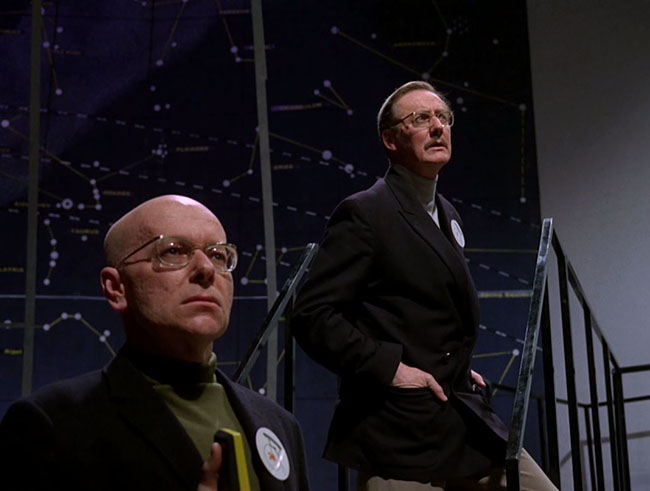
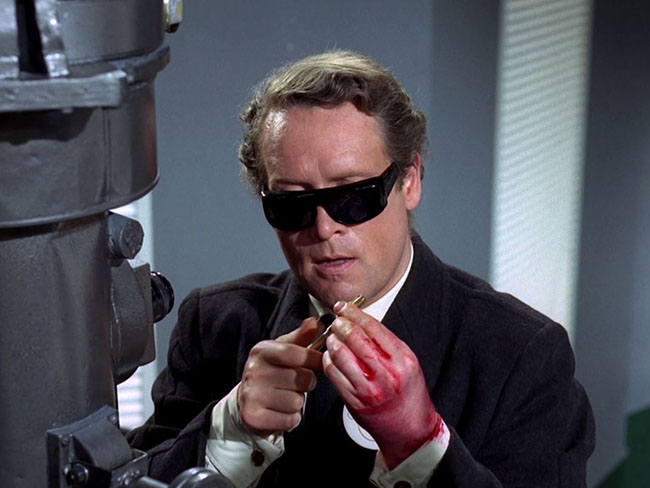
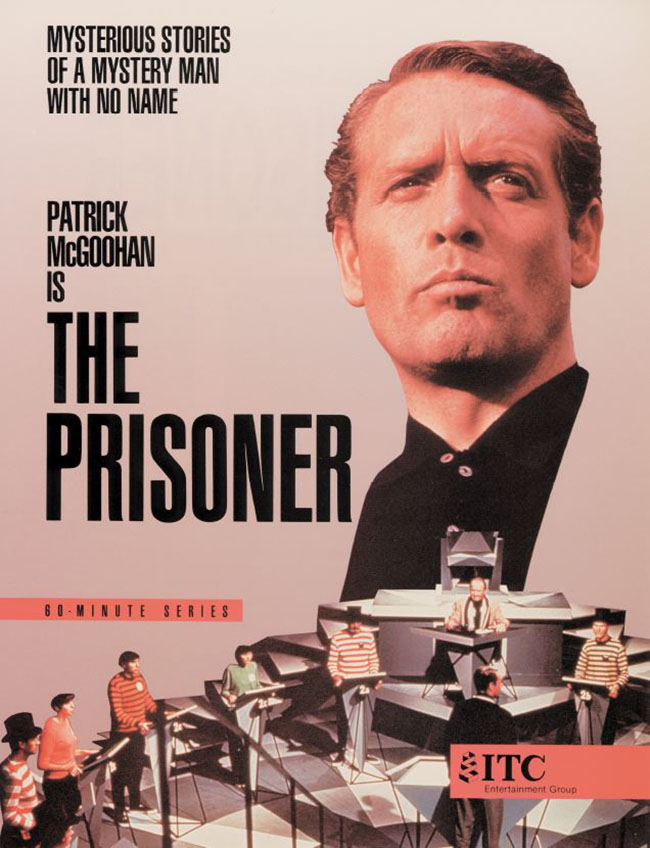
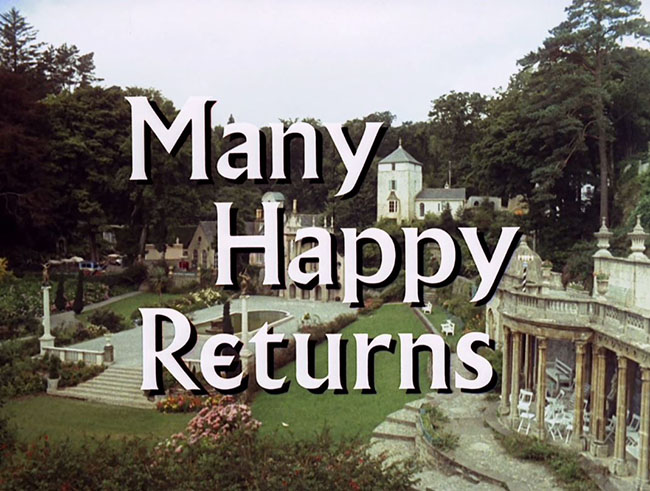 MANY HAPPY RETURNS First UK Broadcast: November 10, 1967 [episode #7 in transmission order] | Written by Anthony Skene | Directed by Joseph Serf (Patrick McGoohan)
MANY HAPPY RETURNS First UK Broadcast: November 10, 1967 [episode #7 in transmission order] | Written by Anthony Skene | Directed by Joseph Serf (Patrick McGoohan)